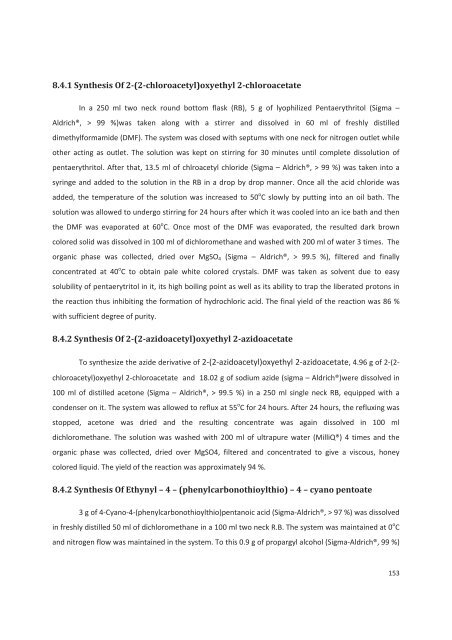4(%3)3 - Ecole nationale supérieure de chimie de Montpellier
4(%3)3 - Ecole nationale supérieure de chimie de Montpellier
4(%3)3 - Ecole nationale supérieure de chimie de Montpellier
Create successful ePaper yourself
Turn your PDF publications into a flip-book with our unique Google optimized e-Paper software.
8.4.1 Synthesis Of 2-(2-chloroacetyl)oxyethyl 2-chloroacetateIn a 250 ml two neck round bottom flask (RB), 5 g of lyophilized Pentaerythritol (Sigma –Aldrich®, > 99 %)was taken along with a stirrer and dissolved in 60 ml of freshly distilleddimethylformami<strong>de</strong> (DMF). The system was closed with septums with one neck for nitrogen outlet whileother acting as outlet. The solution was kept on stirring for 30 minutes until complete dissolution ofpentaerythritol. After that, 13.5 ml of chlroacetyl chlori<strong>de</strong> (Sigma – Aldrich®, > 99 %) was taken into asyringe and ad<strong>de</strong>d to the solution in the RB in a drop by drop manner. Once all the acid chlori<strong>de</strong> wasad<strong>de</strong>d, the temperature of the solution was increased to 50 o C slowly by putting into an oil bath. Thesolution was allowed to un<strong>de</strong>rgo stirring for 24 hours after which it was cooled into an ice bath and thenthe DMF was evaporated at 60 o C. Once most of the DMF was evaporated, the resulted dark browncolored solid was dissolved in 100 ml of dichloromethane and washed with 200 ml of water 3 times. Theorganic phase was collected, dried over MgSO 4 (Sigma – Aldrich®, > 99.5 %), filtered and finallyconcentrated at 40 o C to obtain pale white colored crystals. DMF was taken as solvent due to easysolubility of pentaerytritol in it, its high boiling point as well as its ability to trap the liberated protons inthe reaction thus inhibiting the formation of hydrochloric acid. The final yield of the reaction was 86 %with sufficient <strong>de</strong>gree of purity.8.4.2 Synthesis Of 2-(2-azidoacetyl)oxyethyl 2-azidoacetateTo synthesize the azi<strong>de</strong> <strong>de</strong>rivative of 2-(2-azidoacetyl)oxyethyl 2-azidoacetate, 4.96 g of 2-(2-chloroacetyl)oxyethyl 2-chloroacetate and 18.02 g of sodium azi<strong>de</strong> (sigma – Aldrich®)were dissolved in100 ml of distilled acetone (Sigma – Aldrich®, > 99.5 %) in a 250 ml single neck RB, equipped with acon<strong>de</strong>nser on it. The system was allowed to reflux at 55 o C for 24 hours. After 24 hours, the refluxing wasstopped, acetone was dried and the resulting concentrate was again dissolved in 100 mldichloromethane. The solution was washed with 200 ml of ultrapure water (MilliQ®) 4 times and theorganic phase was collected, dried over MgSO4, filtered and concentrated to give a viscous, honeycolored liquid. The yield of the reaction was approximately 94 %.8.4.2 Synthesis Of Ethynyl – 4 – (phenylcarbonothioylthio) – 4 – cyano pentoate3 g of 4-Cyano-4-(phenylcarbonothioylthio)pentanoic acid (Sigma-Aldrich®, > 97 %) was dissolvedin freshly distilled 50 ml of dichloromethane in a 100 ml two neck R.B. The system was maintained at 0 o Cand nitrogen flow was maintained in the system. To this 0.9 g of propargyl alcohol (Sigma-Aldrich®, 99 %)153











